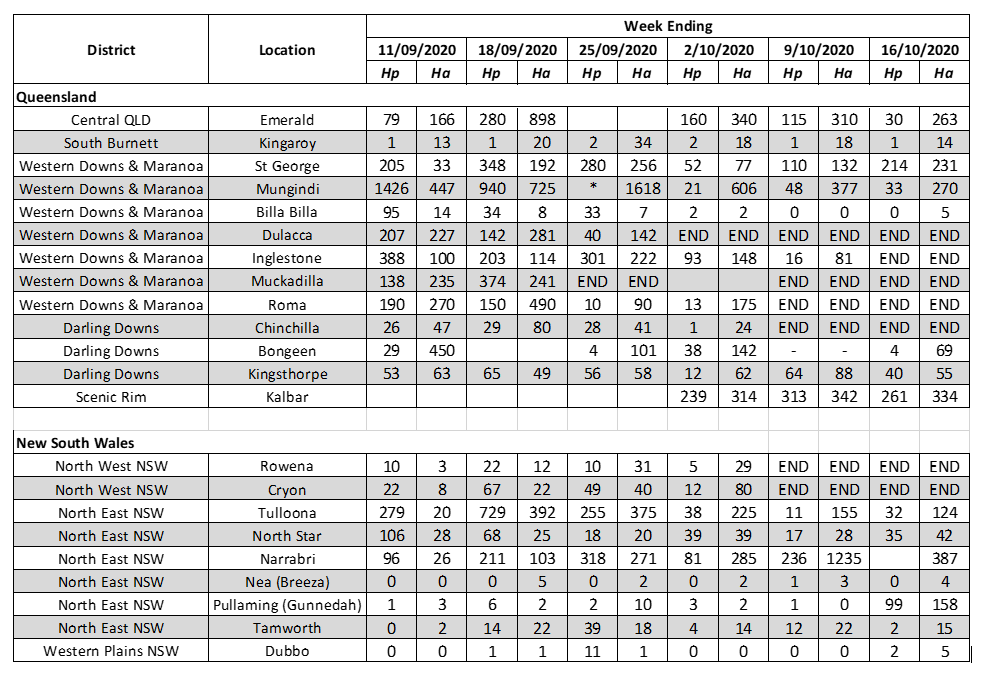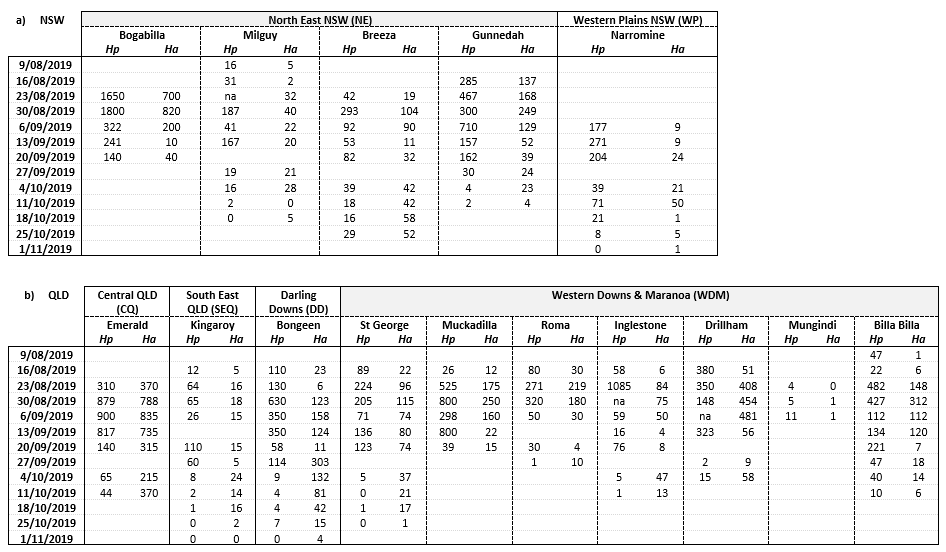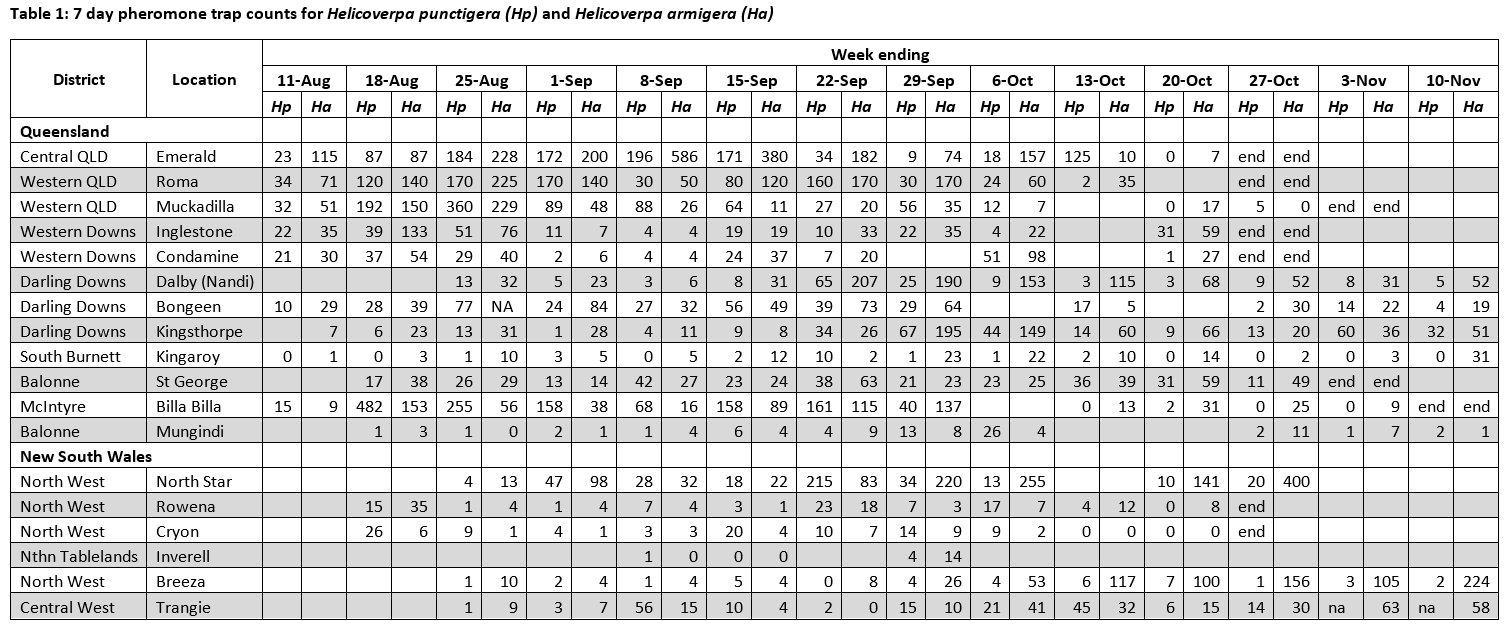The DAF-coordinated helicoverpa trapping program will not be operating in 2021.
Setting up your own pheromone trap(s) to monitor helicoverpa is relatively simple. For more information on suppliers and assembly visit the Beatsheet’s Pheromone traps page.
Using the trap data
It is important to note that the primary function of pheromone traps is not to provide definitive counts, but to act as an ‘early warning’ for adult presence. In-crop sampling is required to accurately assess the presence of eggs and juvenile stages.
A prediction can be generated of when larvae may be present in the field by using DARABUG, a model that provides a convenient and readily available means of predicting development times using insect models. Gridded climatic data of daily temperatures is used to generate estimates of the dates of occurrence for each stage throughout the whole life-cycle of an insect.
The model currently provides estimates for Helicoverpa punctigera (native budworm); Helicoverpa armigera has similar development times.
2020 trapping program
Below is a table displaying the Helicoverpa moth numbers caught in pheromone traps from sites in Queensland and Northern New South Wales. Numbers in the table are standardised counts for seven trap nights, calculated as follows: (total no. moths caught/trap nights) x 7.
Using the trap data to inform management decisions:
- Moth trap data is no substitute for crop checking. Always include regular crop inspections as part of your management strategy.
- The presence of moths in the traps means there are moths in the district. If there are armigera in the traps, you can assume there will be a certain proportion of H. armigera in your crops. The relative numbers of H. armigera and H. punctigera in the traps is not a good indicator of the how many H.armigera and H. punctigera larvae will be in the crop – as discussed below, there are a number of factors that influence egg laying and egg/larval survival in crops.
- Peaks in moth trap catches are good indicators of periods of high moth activity. These could be caused by influxes, emergence from diapause and/or warm night time conditions suitable for moth activity. There hasn’t been work done to try and correlate moth trap catches and larval densities in chickpeas. Consequently, we don’t have a threshold for what number of moths trapped will result in larval densities above economic threshold (see Economic Threshold Calculator). A low number of moths is <20/week, and a very high number is 500-1000 moths/week.
- If you are north of Dubbo – assume there are H. armigera in the crop, and plan your management decisions accordingly.
The northern region Helicoverpa pheromone trap network is part of a national network of traps established through GRDC investment (IPMforGrains: Best Practice Insect Pest Management). Information on trap catches in the southern and western regions are reported in PestFacts and PestFax newsletters (see useful links page).
For more information about pheromone traps, watch a video on how to set up traps on the Beatsheet’s YouTube channel.
This trapping program wouldn’t be possible without the work of our trap operators.
Trapping in previous years:
2019 trapping program
Read our 2019 wrap-up article.
(click the table to enlarge)
2018 trapping program
Read our 2018 wrap-up article.
(click the table to enlarge)
2017 trapping program
View a summary of moth numbers.
(click the table to enlarge)
Maps:
Week ending 10/11:
H. armigera
H. punctigera
Week ending 3/11:
H. armigera
H. punctigera
Week ending 27/10:
H. armigera
H. punctigera
Week ending 20/10:
H. armigera
H. punctigera
Week ending 13/10:
H. armigera
H. punctigera
Week ending 6/10:
H. armigera
H. punctigera
Week ending 29/9:
H. armigera
H. punctigera
Week ending 22/9:
H. armigera
H. punctigera
Week ending 15/9:
H. armigera
H. punctigera
Week ending 8/9:
H. armigera
H. punctigera
Week ending 1/9:
H. armigera
H. punctigera
Week ending 25/8:
H. armigera
H. punctigera
Week ending 18/8:
H. armigera
H. punctigera
Week ending 11/8:
H. armigera
H. punctigera
2016 trapping program
The 2016 trapping program concluded on 11 November. The map below shows the trap locations and total Helicoverpa moths caught (both H. punctigera and H. armigera). Click on a location to access weekly counts.
2015 trapping program
The period of particular interest (H. punctigera immigration flights, and H. armigera emergence from overwintering diapause) concluded on 2 November.
Trapping information was updated weekly on Fridays and/or the following Monday. Click on the location marker to see trap counts.
The Northern region pheromone trap network in 2015 was funded by GRDC as part of the National Pest Information Service project (DAQ00201).
This trap data is only available through the generous cooperation of a number of agronomists and Department staff (QLD DAF, NSW DPI, LLS) across the northern grains region. The 2015 trap watchers were: Jamie Iker (Comet, Rolleston, Capella); Craig Miller (Roma); Hugh Brier (Kingaroy, Byee, Barker’s Creek); Belinda Chase (Nandi), Richard Lloyd (Brookstead); Jamie Street (St George); Bec Raymond (Goondiwindi, Garah); Leigh Norton (North Star); Colin Tann (Narrabri); Bill Manning (Breeza), Sam Simons (Mullaly); Leigh Jenkins (Trangie); Neroli Brennan (Narromine), Patrick McGuinness (Hillston/Hay




